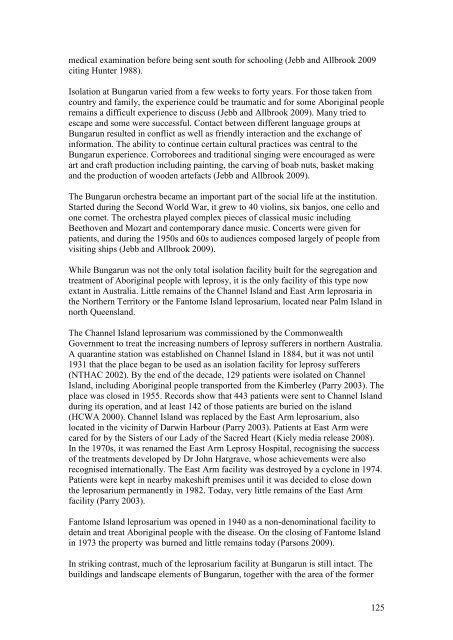WEST KIMBERLEY PLACE REPORT - Department of Sustainability ...
WEST KIMBERLEY PLACE REPORT - Department of Sustainability ...
WEST KIMBERLEY PLACE REPORT - Department of Sustainability ...
You also want an ePaper? Increase the reach of your titles
YUMPU automatically turns print PDFs into web optimized ePapers that Google loves.
medical examination before being sent south for schooling (Jebb and Allbrook 2009<br />
citing Hunter 1988).<br />
Isolation at Bungarun varied from a few weeks to forty years. For those taken from<br />
country and family, the experience could be traumatic and for some Aboriginal people<br />
remains a difficult experience to discuss (Jebb and Allbrook 2009). Many tried to<br />
escape and some were successful. Contact between different language groups at<br />
Bungarun resulted in conflict as well as friendly interaction and the exchange <strong>of</strong><br />
information. The ability to continue certain cultural practices was central to the<br />
Bungarun experience. Corroborees and traditional singing were encouraged as were<br />
art and craft production including painting, the carving <strong>of</strong> boab nuts, basket making<br />
and the production <strong>of</strong> wooden artefacts (Jebb and Allbrook 2009).<br />
The Bungarun orchestra became an important part <strong>of</strong> the social life at the institution.<br />
Started during the Second World War, it grew to 40 violins, six banjos, one cello and<br />
one cornet. The orchestra played complex pieces <strong>of</strong> classical music including<br />
Beethoven and Mozart and contemporary dance music. Concerts were given for<br />
patients, and during the 1950s and 60s to audiences composed largely <strong>of</strong> people from<br />
visiting ships (Jebb and Allbrook 2009).<br />
While Bungarun was not the only total isolation facility built for the segregation and<br />
treatment <strong>of</strong> Aboriginal people with leprosy, it is the only facility <strong>of</strong> this type now<br />
extant in Australia. Little remains <strong>of</strong> the Channel Island and East Arm leprosaria in<br />
the Northern Territory or the Fantome Island leprosarium, located near Palm Island in<br />
north Queensland.<br />
The Channel Island leprosarium was commissioned by the Commonwealth<br />
Government to treat the increasing numbers <strong>of</strong> leprosy sufferers in northern Australia.<br />
A quarantine station was established on Channel Island in 1884, but it was not until<br />
1931 that the place began to be used as an isolation facility for leprosy sufferers<br />
(NTHAC 2002). By the end <strong>of</strong> the decade, 129 patients were isolated on Channel<br />
Island, including Aboriginal people transported from the Kimberley (Parry 2003). The<br />
place was closed in 1955. Records show that 443 patients were sent to Channel Island<br />
during its operation, and at least 142 <strong>of</strong> those patients are buried on the island<br />
(HCWA 2000). Channel Island was replaced by the East Arm leprosarium, also<br />
located in the vicinity <strong>of</strong> Darwin Harbour (Parry 2003). Patients at East Arm were<br />
cared for by the Sisters <strong>of</strong> our Lady <strong>of</strong> the Sacred Heart (Kiely media release 2008).<br />
In the 1970s, it was renamed the East Arm Leprosy Hospital, recognising the success<br />
<strong>of</strong> the treatments developed by Dr John Hargrave, whose achievements were also<br />
recognised internationally. The East Arm facility was destroyed by a cyclone in 1974.<br />
Patients were kept in nearby makeshift premises until it was decided to close down<br />
the leprosarium permanently in 1982. Today, very little remains <strong>of</strong> the East Arm<br />
facility (Parry 2003).<br />
Fantome Island leprosarium was opened in 1940 as a non-denominational facility to<br />
detain and treat Aboriginal people with the disease. On the closing <strong>of</strong> Fantome Island<br />
in 1973 the property was burned and little remains today (Parsons 2009).<br />
In striking contrast, much <strong>of</strong> the leprosarium facility at Bungarun is still intact. The<br />
buildings and landscape elements <strong>of</strong> Bungarun, together with the area <strong>of</strong> the former<br />
125
















